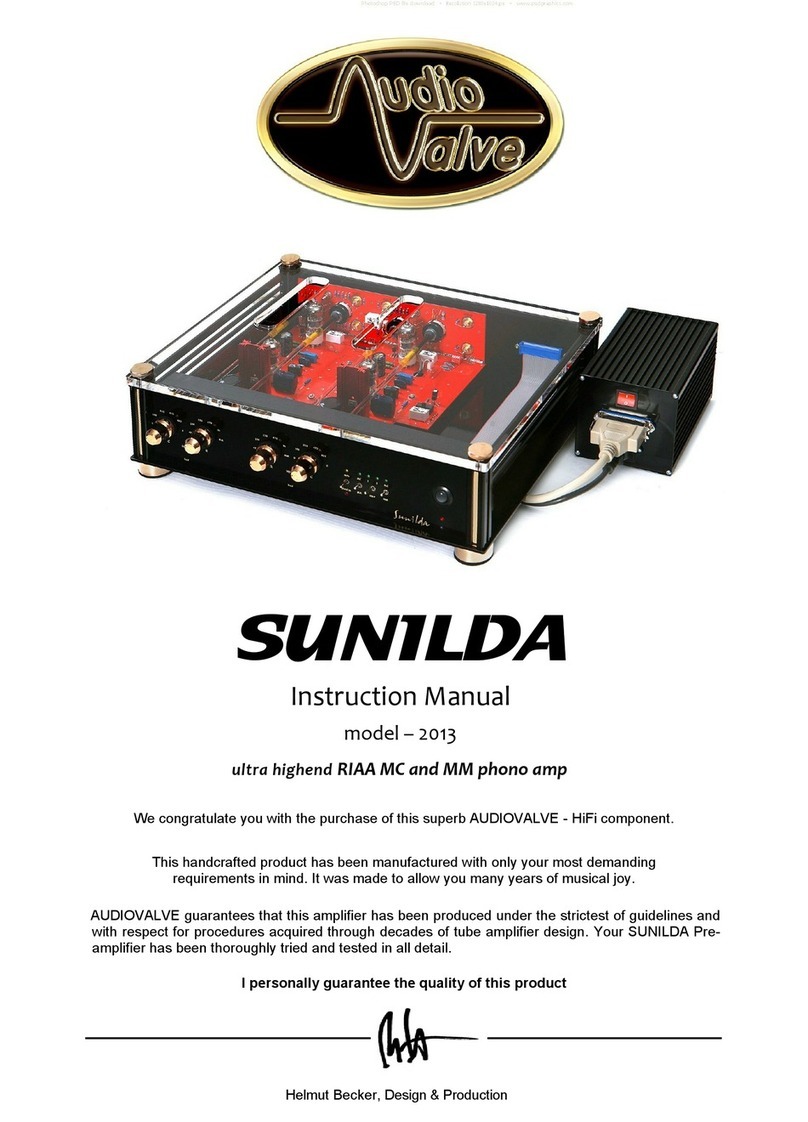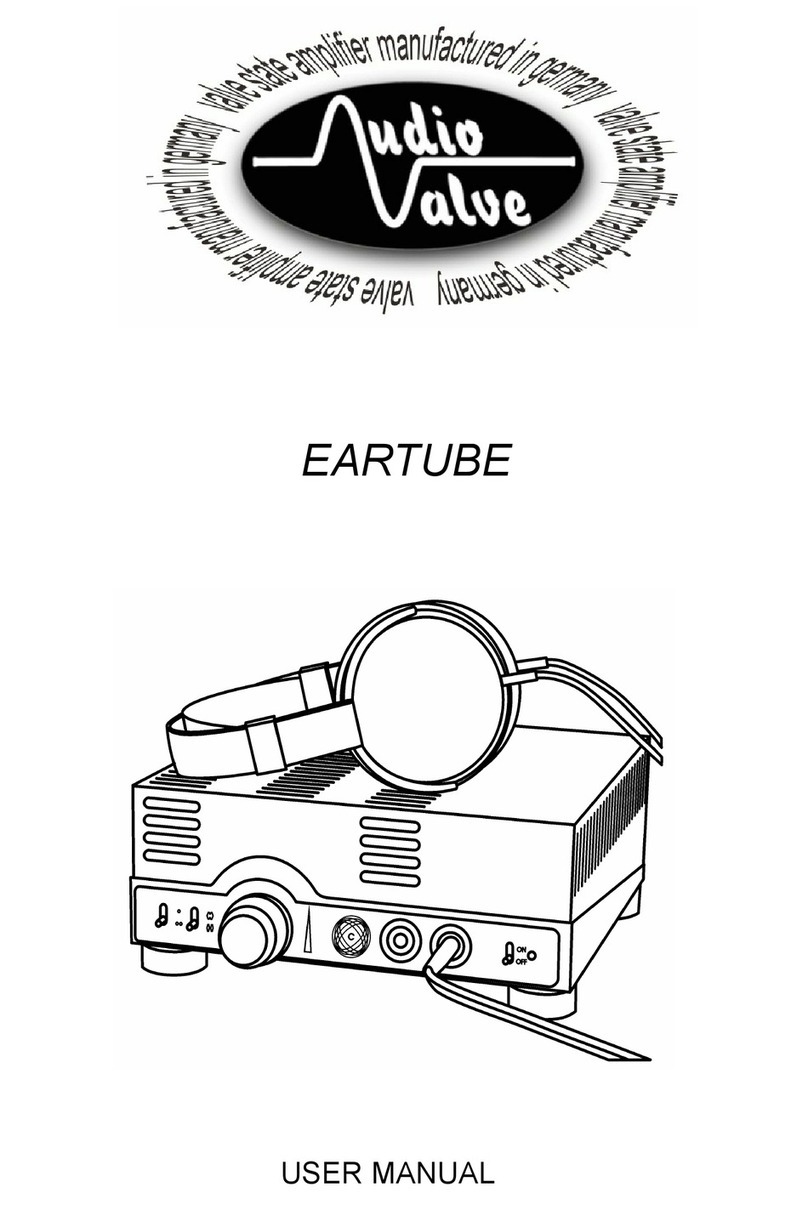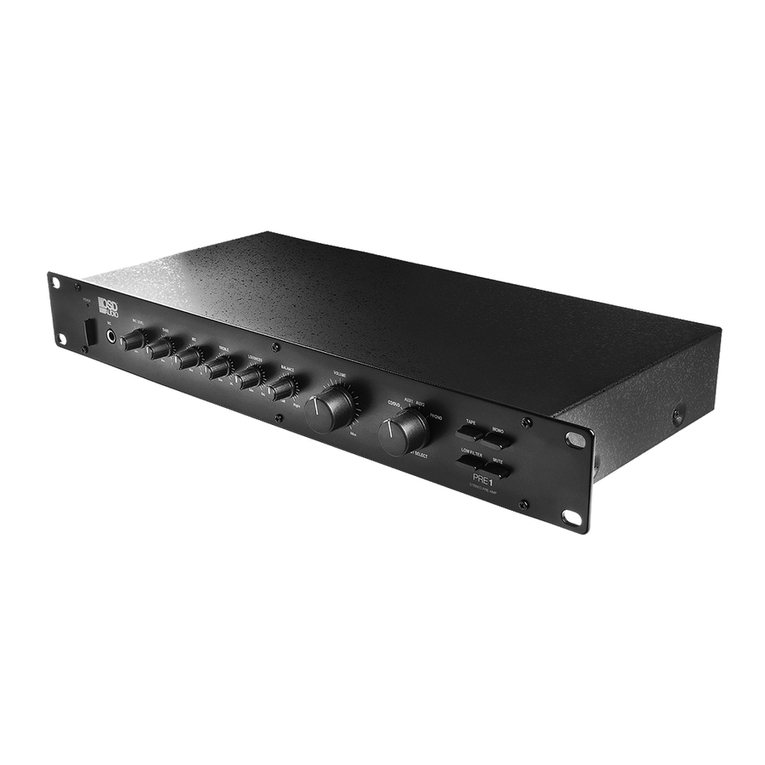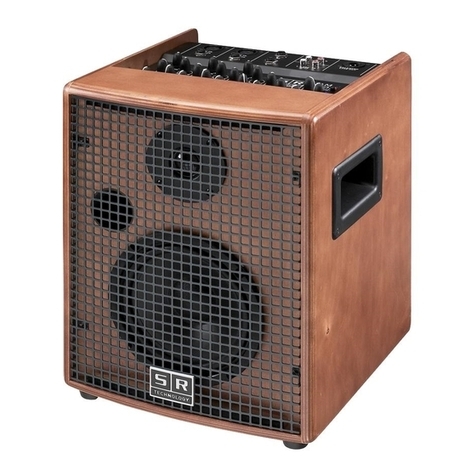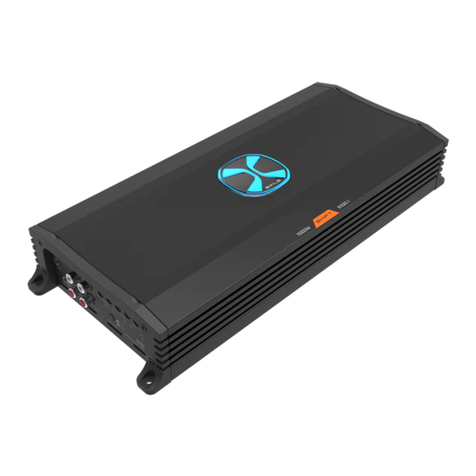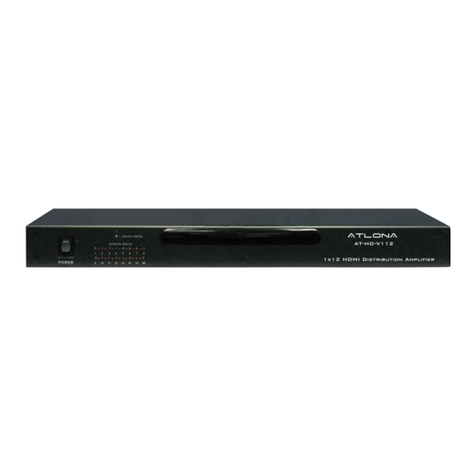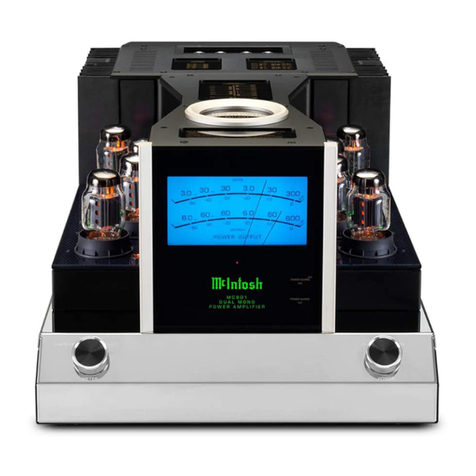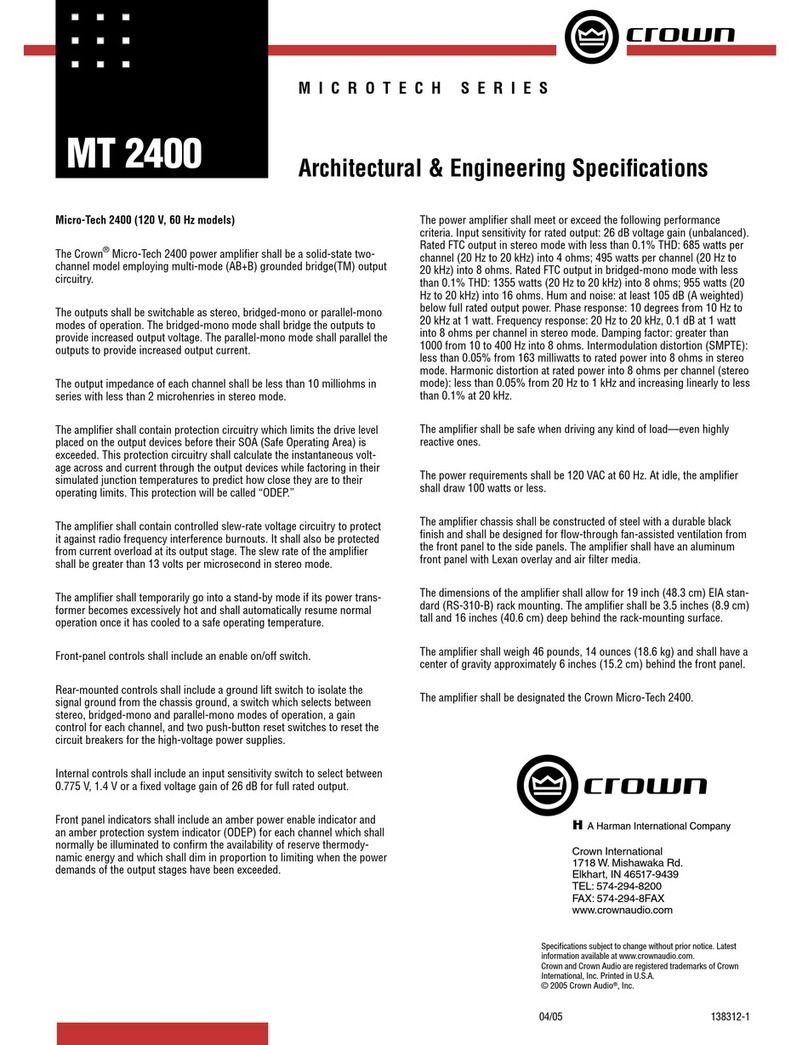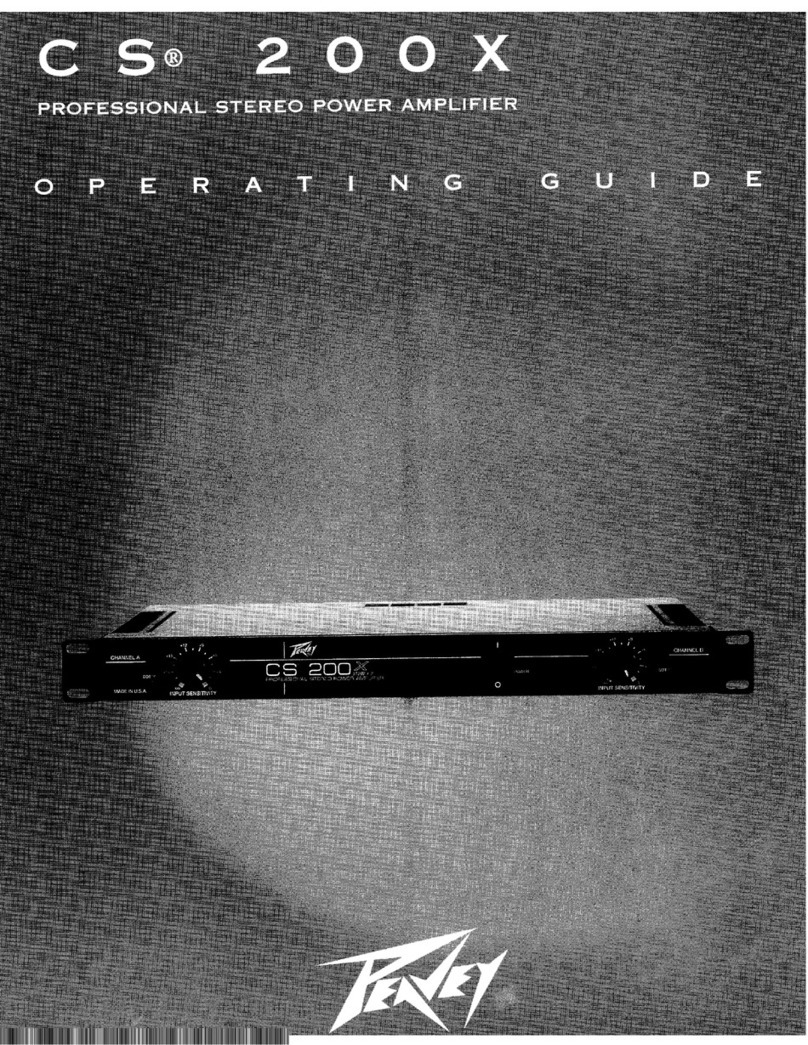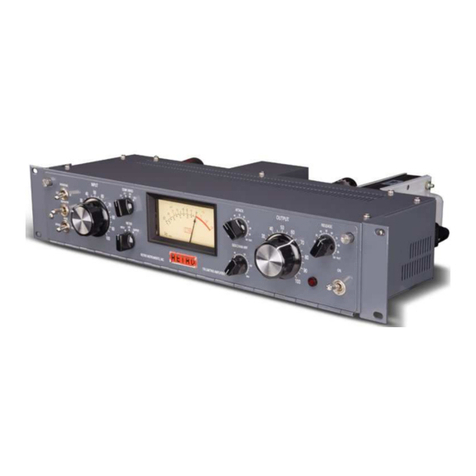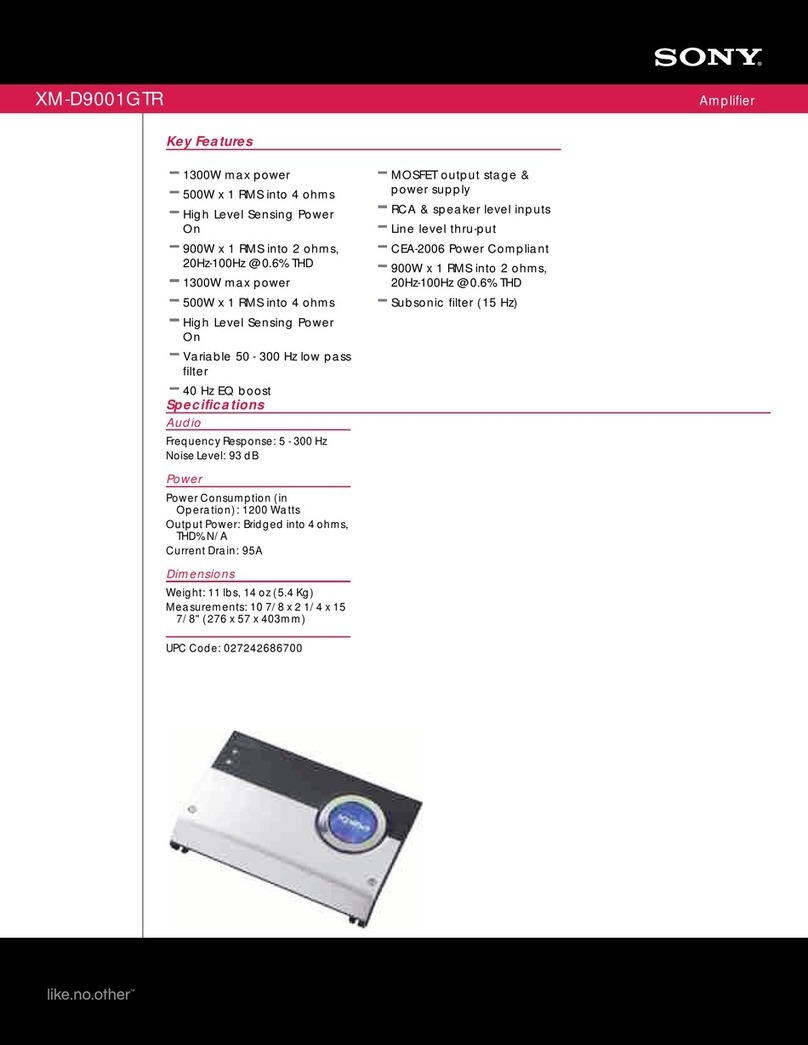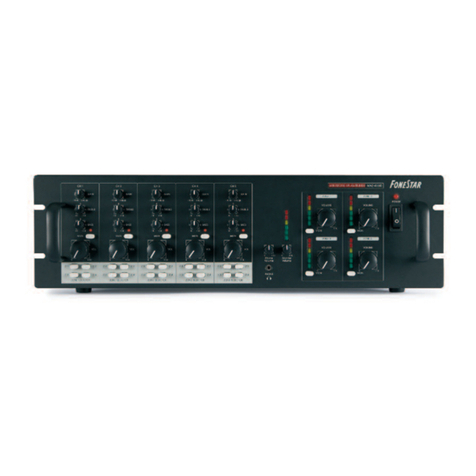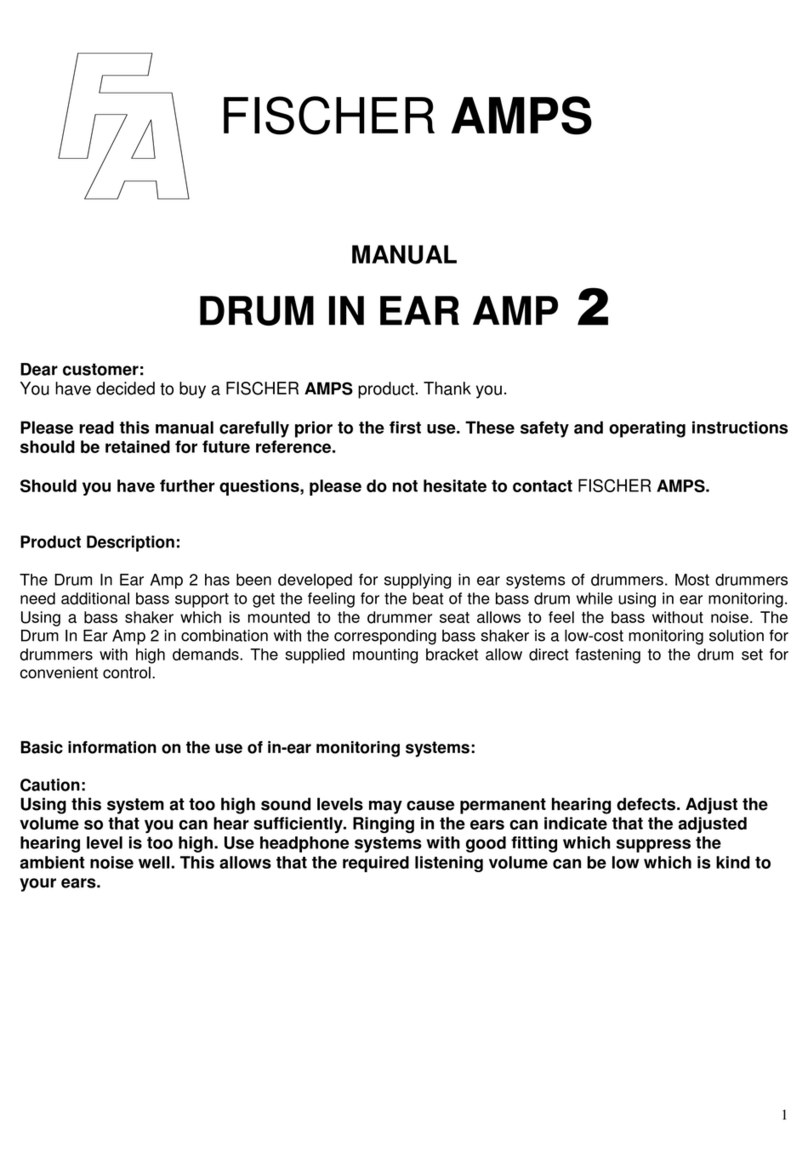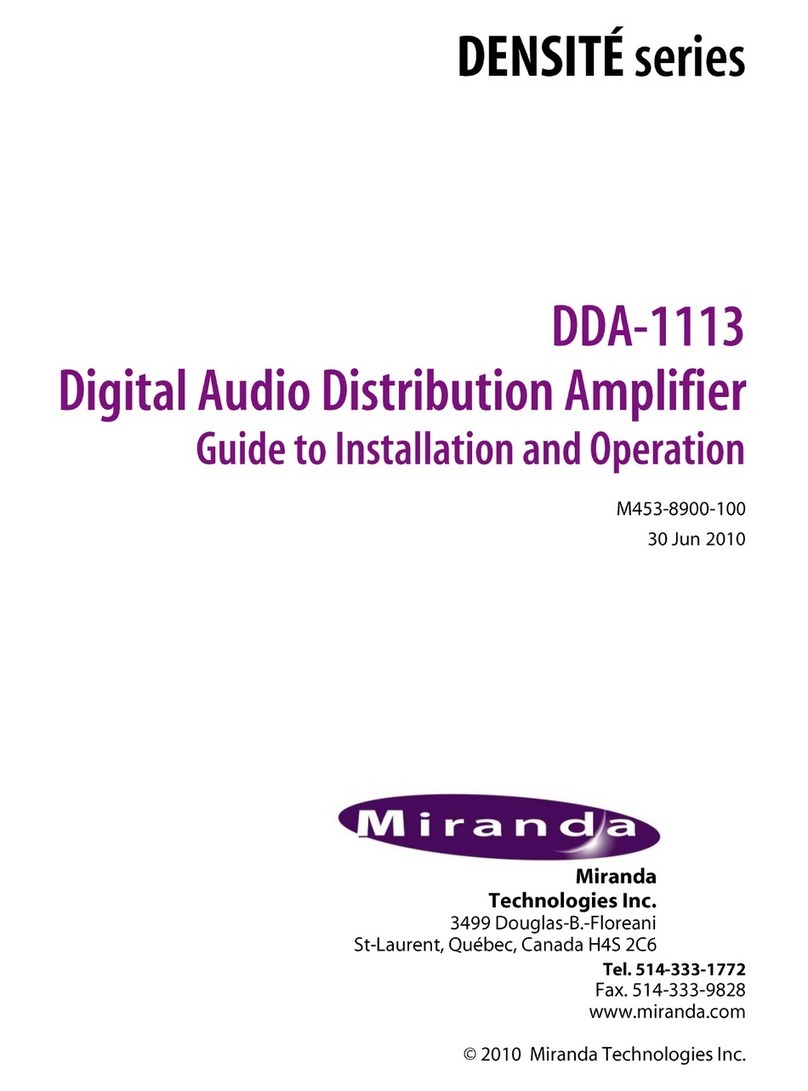Audio Valve EARTUBE- MARK II User manual

EARTUBE – Mark II HEADPHONE AMPLIFIER__
Congratulations
Congratulations on your decision to become the proud owner of the
on your decision to become the proud owner of the EARTUBE
EARTUBE
- MAR II ( or EARTUBE MAR II - USB )
- MAR II ( or EARTUBE MAR II - USB ) tube amplifier.
tube amplifier.
This
This owner manual has been prepared to help you to understand the operation of
owner manual has been prepared to help you to understand the operation of
your amplifier and to provide some information about its design and the variety of
your amplifier and to provide some information about its design and the variety of
ways it may be used.
ways it may be used.
We
We have designed and manufactured this amplifier to faithfully and accurately
have designed and manufactured this amplifier to faithfully and accurately
reproduce music. This hand build instrument should give a lifetime of pleasure
reproduce music. This hand build instrument should give a lifetime of pleasure
Congratulations
Congratulations on your decision to become the proud owner of the
on your decision to become the proud owner of the EARTUBE
EARTUBE
tube amplifier.
tube amplifier.
and with a little care and a full understanding of the operation recommendation in
and with a little care and a full understanding of the operation recommendation in
this manual the
this manual the EARTUBE
EARTUBE should provide trouble free performance.and with a
should provide trouble free performance.and with a
little care and a full understanding of the operation recommendation in this
little care and a full understanding of the operation recommendation in this
manual the
manual the EARTUBE
EARTUBE should provide trouble free performance.
should provide trouble free performance.
- Please take time to read this manual thoroughly before using your amplifier. -
- Please take time to read this manual thoroughly before using your amplifier. -

EARTUBE – Mark II
EARTUBE – Mark II
HEADPHONE AMPLIFIER
HEADPHONE AMPLIFIER
- safety precautions
- safety precautions
- usage
- usage
- connections
- connections
- Activation of the device
- Activation of the device
- Volume control
- Volume control
- Directional listening
- Directional listening
- Listening by headphones
- Listening by headphones
- The natural crossfeed filter
- The natural crossfeed filter
- Activation of crossfeed
- Activation of crossfeed
- eplacing tubes
- eplacing tubes
- integrated Digital
- integrated Digital
Audio Player
Audio Player ( an
( an accessoires in
accessoires in EARTUBE - MAR II - USB
EARTUBE - MAR II - USB )
)
- Technical data
- Technical data
- CE – Confirmity
- CE – Confirmity
- Warranty
- Warranty
–
–Warranty registration
Warranty registration
–
–

EARTUBE – Mark II
EARTUBE – Mark II
HEADPHONE AMPLIFIER
HEADPHONE AMPLIFIER
Safety precautions
Safety precautions
Children and minors are not to use the device and should be kept at a safe distance from
Children and minors are not to use the device and should be kept at a safe distance from
the device while it is running.
the device while it is running.
Do not run the device without the top cover in place. Voltages inside the amp can be
Do not run the device without the top cover in place. Voltages inside the amp can be
lethal and temperatures are high.
lethal and temperatures are high.
Please check that the mains voltage printed on the bottom panel of the amplifier
Please check that the mains voltage printed on the bottom panel of the amplifier
corresponds with the mains voltage in the country where you intend to use the amplifier.
corresponds with the mains voltage in the country where you intend to use the amplifier.
Disconnect the powercord before any service to the amplifier.
Disconnect the powercord before any service to the amplifier.
In the unlikely event of a failure of the device repairs may be performed by authorized
In the unlikely event of a failure of the device repairs may be performed by authorized
technicians only.
technicians only.
Use O IGINAL spare parts only!
Use O IGINAL spare parts only!
Please take note of the fact that we decline product liability for damages caused by our
Please take note of the fact that we decline product liability for damages caused by our
devices, parts and components as a result of:
devices, parts and components as a result of:
Unprofessional and/or faulty and/or incorrect repairs that have been performed in
Unprofessional and/or faulty and/or incorrect repairs that have been performed in
other than the approved repair facilities.
other than the approved repair facilities.
Usage of other than O IGINAL and approved spare parts.
Usage of other than O IGINAL and approved spare parts.
All devices must be operated under moderate climatological circumstances, comparable
All devices must be operated under moderate climatological circumstances, comparable
to those under which human beings usually live. When the surrounding temperature is
to those under which human beings usually live. When the surrounding temperature is
too high, the device will heat up beyond its optimal parameters. This can damage the
too high, the device will heat up beyond its optimal parameters. This can damage the
amplifier.
amplifier.
Proper ventilation is needed, and the amplifier should not be covered in. Allow
Proper ventilation is needed, and the amplifier should not be covered in. Allow
approximately 3 cm of air sidewise and approximately 4 cm above the amplifier to cool
approximately 3 cm of air sidewise and approximately 4 cm above the amplifier to cool
the amplifier.
the amplifier.
Once the amplifier has arrived at its desired destination, make sure the amplifier has
Once the amplifier has arrived at its desired destination, make sure the amplifier has
ample time to adjust to the climate at its new location. It is likely that the changes in
ample time to adjust to the climate at its new location. It is likely that the changes in
temperature and humidity between the last location and the new one, has caused
temperature and humidity between the last location and the new one, has caused
condensation to build up somewhere in the amplifier. This can damage the device. Please
condensation to build up somewhere in the amplifier. This can damage the device. Please
allow the amplifier at least two hours to acclimatise.
allow the amplifier at least two hours to acclimatise.
The amplifier comes fully assembled, ready to go.
The amplifier comes fully assembled, ready to go.
The decive MUST be switched OFF while connecting it to other components.
The decive MUST be switched OFF while connecting it to other components.
A softstart prevents high initial currents through the cold, low impedance, heating
A softstart prevents high initial currents through the cold, low impedance, heating
element. This prevents the element to break at its most narrow spot.
element. This prevents the element to break at its most narrow spot.
For many interested earphone-enthusiasts, who spend a lot of money on their
For many interested earphone-enthusiasts, who spend a lot of money on their
hobby, only a melodious tube amplifier is possible as a driver. The answer to the
hobby, only a melodious tube amplifier is possible as a driver. The answer to the
question: „ Which do I take? “ can only say: the EARTUBE of AudioValve!
question: „ Which do I take? “ can only say: the EARTUBE of AudioValve!

EARTUBE – Mark II
EARTUBE – Mark II
HEADPHONE AMPLIFIER
HEADPHONE AMPLIFIER
The Eartube was developed especially for the highest-quality reproduction with
The Eartube was developed especially for the highest-quality reproduction with
earphonesand serves very well impedances of 8 to 200 ohms. He unfolds his big strength
earphonesand serves very well impedances of 8 to 200 ohms. He unfolds his big strength
with roughly 3,5 watts per canal in 100 ohms. For that reason he is very well suitable
with roughly 3,5 watts per canal in 100 ohms. For that reason he is very well suitable
e.g. for the K1000 by AKG.
e.g. for the K1000 by AKG.
The Eartube is a pure tube amplifier and owns no semiconductor in the signal way.
The Eartube is a pure tube amplifier and owns no semiconductor in the signal way.
Merely the stabilization for the tube heatings and anode tensions occurs highly exactly
Merely the stabilization for the tube heatings and anode tensions occurs highly exactly
with semiconductors.
with semiconductors.
The amplifier owns two switchable entrances with different delicacy. Thus can be
The amplifier owns two switchable entrances with different delicacy. Thus can be
connected, e.g., CD player and TUNE at the same time.
connected, e.g., CD player and TUNE at the same time.
The input circuit of the amplifier owns three tubes of the Type 6N3P and prepares the
The input circuit of the amplifier owns three tubes of the Type 6N3P and prepares the
signal for the output stage tubes. In this area of the circuit also the volume
signal for the output stage tubes. In this area of the circuit also the volume
potentiometer with the shiftable or detachable Crossfeed filter is located, to distribute
potentiometer with the shiftable or detachable Crossfeed filter is located, to distribute
potential signal bass charge on merely one ear to both ears.
potential signal bass charge on merely one ear to both ears.
The output stages use the power Tetrode of the type: QQE 03/12 as the military version
The output stages use the power Tetrode of the type: QQE 03/12 as the military version
by SIEMENS and work in circuit PP with a transformer which is tuned especially to the
by SIEMENS and work in circuit PP with a transformer which is tuned especially to the
interests of earphones.
interests of earphones.
The final tubes work constantly in Class A and are postregulated automatically optimally
The final tubes work constantly in Class A and are postregulated automatically optimally
in the Bias closed current, so that tolerance and aging of the tubes do not matter.
in the Bias closed current, so that tolerance and aging of the tubes do not matter.
The care tensions are won from a strong, free of litter, Torodial-Transfomator. The
The care tensions are won from a strong, free of litter, Torodial-Transfomator. The
amplifier itself rests on one single two-page printed circuit board and was adapted signal-
amplifier itself rests on one single two-page printed circuit board and was adapted signal-
technically optimally. For this reason also the potentiometer is in the rear part of the
technically optimally. For this reason also the potentiometer is in the rear part of the
printed circuit board to hold the signal way short. All parts on the PCB are of the best
printed circuit board to hold the signal way short. All parts on the PCB are of the best
quality and selected carefully to do justice to the requirements of the reproduction in
quality and selected carefully to do justice to the requirements of the reproduction in
every regard. The case is from metal and prevents interferences from the outside. It is
every regard. The case is from metal and prevents interferences from the outside. It is
available in the colours black and silver.
available in the colours black and silver.
Like all products of AudioValve this amplifier also distinguishes itself especially by his
Like all products of AudioValve this amplifier also distinguishes itself especially by his
exceptional musicality which is based at last also on the fantastic technical values of the
exceptional musicality which is based at last also on the fantastic technical values of the
circuit and their stability. As a user you will be able to enjoy this product in the highest
circuit and their stability. As a user you will be able to enjoy this product in the highest
perfection for many years enthusiastically and come with it to the pleasure of
perfection for many years enthusiastically and come with it to the pleasure of
fantastically detached musical reproduction with your headphones
fantastically detached musical reproduction with your headphones.
.

EARTUBE – Mark II
EARTUBE – Mark II
HEADPHONE AMPLIFIER
HEADPHONE AMPLIFIER
Usage
Usage
Dear AudioValve fan,
Dear AudioValve fan,
we are delighted that you have for your audio - have bought a device from AudioValve
we are delighted that you have for your audio - have bought a device from AudioValve
hobby. We know this much appreciated and will always strive to meet your expectations.
hobby. We know this much appreciated and will always strive to meet your expectations.
The Eartube Mark II is a logical development of our highly successful predecessor models
The Eartube Mark II is a logical development of our highly successful predecessor models
Eartube. This amplifier is designed for playing music through headphones in the first
Eartube. This amplifier is designed for playing music through headphones in the first
place, and can act in different impedances. You can also use the amplifier but also for
place, and can act in different impedances. You can also use the amplifier but also for
playing background music about speakers. Playing music through speakers has minor
playing background music about speakers. Playing music through speakers has minor
importance because the power of the amplifier is rated for headphones.
importance because the power of the amplifier is rated for headphones.
The
The AudioValve - EARTUBE Mark II
AudioValve - EARTUBE Mark II is a small-power amplifier, specially designed to drive
is a small-power amplifier, specially designed to drive
headphones. It offers a sound quality and driving capabilities far beyond that of an
headphones. It offers a sound quality and driving capabilities far beyond that of an
ordinary headphone socket found on a CD-player or amplifier and thus allows you to
ordinary headphone socket found on a CD-player or amplifier and thus allows you to
exploit the full sonic potential of your headphones.
exploit the full sonic potential of your headphones.
Due to the close contact to your ears, headphones provide an extreme channel
Due to the close contact to your ears, headphones provide an extreme channel
separation whilst listening to stereo recordings. Unlike loudspeakers, none of the sonic
separation whilst listening to stereo recordings. Unlike loudspeakers, none of the sonic
information in the left channel is acoustically transferred to the right ear and vice versa.
information in the left channel is acoustically transferred to the right ear and vice versa.
Although this adds to the extreme high level of detail that can be achieved with
Although this adds to the extreme high level of detail that can be achieved with
headphones, it subconsciously also introduces mental stress. The natural correlation of
headphones, it subconsciously also introduces mental stress. The natural correlation of
stereo sound interpreted by the brain is lost.
stereo sound interpreted by the brain is lost.
The
The AudioValve - EARTUBE Mark II
AudioValve - EARTUBE Mark II not only offers normal stereo reproduction of your
not only offers normal stereo reproduction of your
music, but it also has a facility to add some of the left channel information to that of the
music, but it also has a facility to add some of the left channel information to that of the
right channel and vice versa. Thus mental stress is reduced and music can be enjoyed
right channel and vice versa. Thus mental stress is reduced and music can be enjoyed
with more ease.
with more ease.
By design only tubes are found inside the signal path of the amp. Solid state electronics
By design only tubes are found inside the signal path of the amp. Solid state electronics
are only used to create a stable voltage supply.
are only used to create a stable voltage supply.
For safety and in order to obtain the best possible results with your new headphone
For safety and in order to obtain the best possible results with your new headphone
preamplifier, we ask you to read these instructions carefully. The
preamplifier, we ask you to read these instructions carefully. The EARTUBE
EARTUBE was
was
developed by music-lovers for music-lovers and we hope that it will serve you well for a
developed by music-lovers for music-lovers and we hope that it will serve you well for a
long time.
long time.

EARTUBE – Mark II
EARTUBE – Mark II HEADPHONE AMPLIFIER
HEADPHONE AMPLIFIER
Connections
Connections
At the rear side of the
At the rear side of the AudioValve - EARTUBE Mark II
AudioValve - EARTUBE Mark II two pairs of inputs ( 1 + 2 ) allow
two pairs of inputs ( 1 + 2 ) allow
you to connect two different audio sources that have typical output voltages (CD- player,
you to connect two different audio sources that have typical output voltages (CD- player,
cassette-player, tuner, minidisc-player, ...). The source you want to listen to can be
cassette-player, tuner, minidisc-player, ...). The source you want to listen to can be
selected by the rocker switch at the left front side of the amp.
selected by the rocker switch at the left front side of the amp.
The EA TUBE can also be used as a preamp. He has two gold-plated XL female
The EA TUBE can also be used as a preamp. He has two gold-plated XL female
connectors for even the back wall, which also vary in level with the volume control. With
connectors for even the back wall, which also vary in level with the volume control. With
two sockets, for the left and right channel, only the pin 2 is occupied hot plus phase.
two sockets, for the left and right channel, only the pin 2 is occupied hot plus phase.
Your headphone should be connected to one of the headphone - sockets on the front side
Your headphone should be connected to one of the headphone - sockets on the front side
of the
of the EARTUBE
EARTUBE. You can also use the sockets to connect two headphones
. You can also use the sockets to connect two headphones
simultaneously.
simultaneously.
The sockets are intended for 6.35 mm stereo jacks. If your headphone only has a 3.5
The sockets are intended for 6.35 mm stereo jacks. If your headphone only has a 3.5
mm jack, then use an adapter that can be obtained in most electronics or audio shops.
mm jack, then use an adapter that can be obtained in most electronics or audio shops.

EARTUBE – Mark II
EARTUBE – Mark II HEADPHONE AMPLIFIER
HEADPHONE AMPLIFIER
Activation of the device /
Activation of the device / front panel terminals
front panel terminals
Before connection of the
Before connection of the AudioValve - EARTUBE Mark II
AudioValve - EARTUBE Mark II to the mains, please check the
to the mains, please check the
voltage required. The proper value can be found on the bottom-side of your device.
voltage required. The proper value can be found on the bottom-side of your device.
After connection the
After connection the EARTUBE
EARTUBE can be switched ON / OFF by the power switch on the
can be switched ON / OFF by the power switch on the
front panels right side, but turn down at first the VOLUME control. While switched ON the
front panels right side, but turn down at first the VOLUME control. While switched ON the
stereo volume meters on the front side will be lit. It takes around 30 seconds before the
stereo volume meters on the front side will be lit. It takes around 30 seconds before the
amp is fully activated.
amp is fully activated.
We recommend to power the amplifier ON approximately 1 minutes before use. If the
We recommend to power the amplifier ON approximately 1 minutes before use. If the
device is not used for a longer period of time it should be switched OFF. Not only does
device is not used for a longer period of time it should be switched OFF. Not only does
this reduce energy consumption but it also increases life-time of the tubes.
this reduce energy consumption but it also increases life-time of the tubes.
On the left side you can select your audio soure with an vertikal rocker switch. The
On the left side you can select your audio soure with an vertikal rocker switch. The
standard version Mark II has 2 - switch positions, the USB version 3 - switch positions.
standard version Mark II has 2 - switch positions, the USB version 3 - switch positions.
So you can select with its switch the backside input CA jackets, soure 1 or soure 2.
So you can select with its switch the backside input CA jackets, soure 1 or soure 2.
The USB version has a middle switch position and activate the internal digital player.
The USB version has a middle switch position and activate the internal digital player.
1
1-
- LINE 1
LINE 1
middle
middle - digital player
- digital player
2
2-
- LINE 2
LINE 2
Near by its switch you will be find the C OSS FEED switch. The describtion its function
Near by its switch you will be find the C OSS FEED switch. The describtion its function
you find it in this manual on a other page. You can use 3 modes for its function.
you find it in this manual on a other page. You can use 3 modes for its function.
X
X-
- CROSS
CROSS
FEED
FEED filter
filter
middle
middle -
- MIX
MIX off both
off both
II
II -
- STEREO
STEREO
Volume and balance control
Volume and balance control
The volume of the
The volume of the AudioValve - EARTUBE Mark II
AudioValve - EARTUBE Mark II is controlled by the large ALPS dial pot.
is controlled by the large ALPS dial pot.
on the middle of the front panel and is increased by clock - wise rotation.
on the middle of the front panel and is increased by clock - wise rotation.
The driving capabilities of the
The driving capabilities of the AudioValve - EARTUBE Mark II
AudioValve - EARTUBE Mark II by far exceed that of a
by far exceed that of a
regular CD-player. This not only guarantees less distortion, but also has the danger of
regular CD-player. This not only guarantees less distortion, but also has the danger of
severe hearing damage.
severe hearing damage.
While listening to headphones we lack several feedback mechanisms on volume level that
While listening to headphones we lack several feedback mechanisms on volume level that
are present when we listen to loudspeakers. Much less distortion, no feeling of the lower
are present when we listen to loudspeakers. Much less distortion, no feeling of the lower
frequencies by our body and no psychological restraints not to annoy our fellow-men
frequencies by our body and no psychological restraints not to annoy our fellow-men
easily seduces us to listen at volume levels that are detrimental to our hearing.
easily seduces us to listen at volume levels that are detrimental to our hearing.
Hearing damage from regular exposure to high sound levels progresses slowly but is
Hearing damage from regular exposure to high sound levels progresses slowly but is
irreversible and can result in permanent hearing loss. The little knob left side from the
irreversible and can result in permanent hearing loss. The little knob left side from the
VOLUME pot. handle your balance between the channels and allows a correction from +/-
VOLUME pot. handle your balance between the channels and allows a correction from +/-
2dB.
2dB.
!! Please choose your volume-setting with caution !!
!! Please choose your volume-setting with caution !!

EARTUBE – Mark II
EARTUBE – Mark II HEADPHONE AMPLIFIER
HEADPHONE AMPLIFIER
Directional listening
Directional listening
In normal daily life people use various mechanisms to locate sources of sound.
In normal daily life people use various mechanisms to locate sources of sound.
Firstly, the sound of a source to the right side of the listener (e.g. the right loudspeaker)
Firstly, the sound of a source to the right side of the listener (e.g. the right loudspeaker)
not only reaches the right ear but, attenuated and delayed, is also heard by the left ear.
not only reaches the right ear but, attenuated and delayed, is also heard by the left ear.
The level of attenuation and the delay time of this crossfeed signal provide important
The level of attenuation and the delay time of this crossfeed signal provide important
directional information.
directional information.
Secondly, the soundwaves are partly absorbed and partly reflected by the tissues of the
Secondly, the soundwaves are partly absorbed and partly reflected by the tissues of the
head. eflections at the oracles (pinnae) interfere with the soundwaves that directly
head. eflections at the oracles (pinnae) interfere with the soundwaves that directly
enter the ear-channel and amplify or attenuate specific frequency components. Since
enter the ear-channel and amplify or attenuate specific frequency components. Since
these reflections depend on the direction of the soundwave the “color” of the sound
these reflections depend on the direction of the soundwave the “color” of the sound
changes with the direction of the source.
changes with the direction of the source.
Thirdly, reflections of the soundwaves from the walls, ceiling and floor of our listening
Thirdly, reflections of the soundwaves from the walls, ceiling and floor of our listening
room produce reverberation that conveys an extra feeling of space.
room produce reverberation that conveys an extra feeling of space.
The information obtained by these mechanisms is further refined by movements of the
The information obtained by these mechanisms is further refined by movements of the
head. Changes in sound levels, delay times and sound color refine the sense of direction.
head. Changes in sound levels, delay times and sound color refine the sense of direction.
For a demonstration, blindfold a friend and ask him to locate a ticking clock that you
For a demonstration, blindfold a friend and ask him to locate a ticking clock that you
have hidden in the room. He will start turning his head although he can’t see anything.
have hidden in the room. He will start turning his head although he can’t see anything.
With his head in a fixed position an exact localization is much more difficult.
With his head in a fixed position an exact localization is much more difficult.

EARTUBE – Mark II
EARTUBE – Mark II HEADPHONE AMPLIFIER
HEADPHONE AMPLIFIER
Listening by headphones
Listening by headphones
All these mechanisms are missing when we listen to music by headphones. The sound at
All these mechanisms are missing when we listen to music by headphones. The sound at
the right ear will no longer reach the left ear and pinnae-reflections no longer interfere
the right ear will no longer reach the left ear and pinnae-reflections no longer interfere
with the original soundwave. Moreover, the headphones are directly attached to our
with the original soundwave. Moreover, the headphones are directly attached to our
head, and so head movements no longer add information. everberation is also not
head, and so head movements no longer add information. everberation is also not
present.
present.
As a result, the sound heard by headphones seems to stick to the inside of our head and
As a result, the sound heard by headphones seems to stick to the inside of our head and
to our ears and an unnatural soundfield is created. The brain misses logical clues for
to our ears and an unnatural soundfield is created. The brain misses logical clues for
direction and this subconsciously results in mental stress. Some people cannot tolerate
direction and this subconsciously results in mental stress. Some people cannot tolerate
this stress and are unable to use headphones.
this stress and are unable to use headphones.
The natural crossfeed filter
The natural crossfeed filter
In principle, digital soundprocessors can simulate all the mechanisms for directional
In principle, digital soundprocessors can simulate all the mechanisms for directional
listening but the results are, thus far, not very satisfactory. In particular, pinnae-
listening but the results are, thus far, not very satisfactory. In particular, pinnae-
reflections are very complex and listener-specific and impossible to simulate accurately.
reflections are very complex and listener-specific and impossible to simulate accurately.
Fortunately, the main directional information is provided by the time delay and level of
Fortunately, the main directional information is provided by the time delay and level of
attenuation of the sounds that reaches the opposite ear. The
attenuation of the sounds that reaches the opposite ear. The AudioValve - EARTUBE
AudioValve - EARTUBE
Mark II
Mark II can electronically simulate this process and, with appropriate attenuation and
can electronically simulate this process and, with appropriate attenuation and
delay, add some of the right audiosignal to the left channel and vice -versa. This
delay, add some of the right audiosignal to the left channel and vice -versa. This
considerably reduces the adverse symptoms of headphone listening.
considerably reduces the adverse symptoms of headphone listening.
A unique feature of the crossfeed circuitry of the
A unique feature of the crossfeed circuitry of the EARTUBE-1
EARTUBE-1 is that it “recognizes” the
is that it “recognizes” the
virtual positions of the instruments and singers in a recording. The sound of an
virtual positions of the instruments and singers in a recording. The sound of an
instrument in the middle of the soundstage will be equally present in both audio-channels
instrument in the middle of the soundstage will be equally present in both audio-channels
and isn’t given any crossfeed. A crossfeed signal is only generated for instruments that
and isn’t given any crossfeed. A crossfeed signal is only generated for instruments that
are not placed at the center. The more off-center the instrument is placed, the stronger
are not placed at the center. The more off-center the instrument is placed, the stronger
the crossfeed and the longer its delay. This feature is called “natural crossfeed”.
the crossfeed and the longer its delay. This feature is called “natural crossfeed”.
Activation of crossfeed
Activation of crossfeed
The crossfeed filter can be activated by the second left switch at the front of the amp.
The crossfeed filter can be activated by the second left switch at the front of the amp.
Lower position STEREO.
Lower position STEREO.
In this position there is no crossfeed on the headphone outputs. We recommend this
In this position there is no crossfeed on the headphone outputs. We recommend this
position for recordings with a narrow soundstage.
position for recordings with a narrow soundstage.
Upper position LOW level crossfeed
Upper position LOW level crossfeed
This setting is especially recommended for recordings with a relatively high level of
This setting is especially recommended for recordings with a relatively high level of
reverberation (orchestra, choir) or extreme spatial positioning. Although the difference to
reverberation (orchestra, choir) or extreme spatial positioning. Although the difference to
the stereo position may not be discernable to you at first, after longer periods of
the stereo position may not be discernable to you at first, after longer periods of
listening you will find the crossfeed position much more relaxing.
listening you will find the crossfeed position much more relaxing.
While activating the crossfeed the listener may notice an apparent lack of bass. In stereo
While activating the crossfeed the listener may notice an apparent lack of bass. In stereo
mode, lower frequencies seem to be much more present. This is a psycho-acoustical
mode, lower frequencies seem to be much more present. This is a psycho-acoustical
effect and does not represent a limitation of the crossfeed filter. Lower frequencies heard
effect and does not represent a limitation of the crossfeed filter. Lower frequencies heard
by one ear only are much more unnatural to our brain than higher frequencies and
by one ear only are much more unnatural to our brain than higher frequencies and
therefore in stereo mode are more noticeable. Crossfeed integrates the lower frequencies
therefore in stereo mode are more noticeable. Crossfeed integrates the lower frequencies
in a more natural way into the soundstage which makes them less noticeable.
in a more natural way into the soundstage which makes them less noticeable.

EARTUBE – Mark II
EARTUBE – Mark II HEADPHONE AMPLIFIER
HEADPHONE AMPLIFIER
Replacing tubes
Replacing tubes
The
The EARTUBE
EARTUBE uses three tubes 6N3P and two tubes QQE 03-12 (or its equivalents GU17,
uses three tubes 6N3P and two tubes QQE 03-12 (or its equivalents GU17,
S1023, 6360)
S1023, 6360)
If you want to exchange tubes, please disconnect the power cord before removal of the
If you want to exchange tubes, please disconnect the power cord before removal of the
top cover. Also make sure that all pins are properly mounted into the sockets. It is not
top cover. Also make sure that all pins are properly mounted into the sockets. It is not
uncommon that a pin is bend and doesn't enter the socket.
uncommon that a pin is bend and doesn't enter the socket.
Do not run the device without the top cover in place!
Do not run the device without the top cover in place!

EARTUBE – Mark II
EARTUBE – Mark II HEADPHONE AMPLIFIER
HEADPHONE AMPLIFIER
EARTUBE MAR II - USB
EARTUBE MAR II - USB
integrated Digital
integrated Digital
Audio Player, FM reseiver and Equalizer
Audio Player, FM reseiver and Equalizer
In its amplifier model variante, we
In its amplifier model variante, we
have installed a very populare
have installed a very populare accessoires
accessoires – a
– a
DIGITAL audio player for USB sticks or SD cards with FM radio and remote
DIGITAL audio player for USB sticks or SD cards with FM radio and remote
control.
control.
Its player can handle memory size up to 8 GB and supported MP3 and WAV
Its player can handle memory size up to 8 GB and supported MP3 and WAV
files from USB sticks or Memory cards. You can direct select your music titles by
files from USB sticks or Memory cards. You can direct select your music titles by
push buttons on the front its modul, or with the remote control. Its nice to handle
push buttons on the front its modul, or with the remote control. Its nice to handle
and simple to use and satisfight everyone who like to hear memorized digit music
and simple to use and satisfight everyone who like to hear memorized digit music
from sticks as back ground music – all in realy nice accessoires. Its player has an
from sticks as back ground music – all in realy nice accessoires. Its player has an
„AUTO STA T“ function when the USB or memory stick plugged.
„AUTO STA T“ function when the USB or memory stick plugged.
Feartures:
Feartures:
* Play music from any USB / sticks or SD - card up to max. 8 GB with P3 or WAV format files
* PLL - F radio with auto scan integrated
* Built in RTC clock cirucit with time /alarm function
* P3 / WAV decorder support 32–320kbps.
* 18-bit resolution with no missing codes, Dynamic range: 99 dB, sample rate: 48kHz
* Play/Pause, Next , Previous , Vol- ,Vol+, Stop, EQ, Repeat , ute
* FAT16 or FAT32 systems supported
* emory the song number and volume even power cut down
* Remote control
* nice lightning LCD display

EARTUBE – Mark II
EARTUBE – Mark II HEADPHONE AMPLIFIER
HEADPHONE AMPLIFIER
Keys function on Pannel
Power : Long press for stanby ,and lon g press again will wake up .
Set : Setting for Time Alarm Sleep Language Finish
VOL- : Volume down and minus for setting Time , Alarm ,and Timing swith off.
VOL+: Volume down and Plus for setting Time , Alarm ,and Timing swith off.
Play/Pause : Short press for Paly or Pause for USB and SD state (also for
auto-search channels and save them in FM state)
Remote Control eys function
Power : ON/OFF (standby )
Mode : Switch order will be USB SD FM USB (if have USB memory and SD card) , Switch order will be
USB FM USB (if only have USB memory) Switch order will be SD FM SD (if only have SD card )
P EV :Same functions as Previous Button on pannel
NEXT: Same functions as Next Button on pannel
VOL+ : Same functions as VOL+ Button on pannel
VOL-: Same functions as VOL- Button on pannel
EP: For switching one song repeat or all song repeat in USB/SD state,
default is all song repeat .
*SET : Setting for Time Alarm Sleep Language Finish
MUTE: First press mute , press again will release from mute.
EQ : NO MAL, JAZZ, OCK, POP, CLASSIC, COUNT Y
PLAY/PAUSE : For play and pause in USB/SD state , for auto-search
channel and save them in FM state.
Button 0-9 : select song in USB/SD state, if the song number over 9 , just input the numbers in series.
NOTE:
If you are using digital player not used, turn it off. To check the main switch operated on the front
panel of the player or the remote.


EARTUBE – Mark II
EARTUBE – Mark II HEADPHONE AMPLIFIER
HEADPHONE AMPLIFIER
technicial specifications – all EARTUBE basic models:
technicial specifications – all EARTUBE basic models:
Bass - crossfeed filter is implemented ( switchable )
power output: 2 * 3,5 watt
Tube: 3 x N3P and 2 x QQE 03/12 (Siemens long life military version).
2 high quality NEUTRIK headphone output jackets ,3mm on front
Gain factor: Input 1: (14,5 dB), Input 2: (21,5 dB)
2 pairs of Gold-plated RCA – input jacks
1 pair VOLUME controlled XLR pre – wireing outputs for separate POWER AMPLIFIERS.
S/N ration 100 dB
channel separation 70dB
power band wide 8 - 80.000 hz
Input impedance 47 kOhm
impedances headphones: 8 - up to 200
Silver or gold plated knobs – silver or black havy laser cuted steel case .
Alps log- - potentiometer for volume control.
100 and 245 VAC main voltage versions available.
Earthground / signalground floating connected
high precisition plate and heating voltage lines.
power consumption 100 VA
Weight: 10 kg.
Size: wide: 38cm x deeph: 2 cm x high: 12cm.

EARTUBE – Mark II
EARTUBE – Mark II
HEADPHONE AMPLIFIER
HEADPHONE AMPLIFIER
CE – Confirmity
CE – Confirmity
Declaration Of Conformity
Declaration Of Conformity
Manufacturer: AudioValve,
Germany, 34123 KASSEL, Umbachsweg 70,
Product Name: ASSISTENT 100
Product Type: Audio Amplifier
Complies with Standards:
LVD: 92/31/EEC, 93/68/EEC, & 73/23/EWG
Safety: EN60065
EMC: EN55013, EN55020, EN55022, EN55103,
EN61000-3-2, & EN61000-3-3
The official Declaration of Conformity for this product is kept on file at: AudioValve,
34123 Kassel,Umbachsweg 70, Tel. 05617013360

EARTUBE – Mark II
EARTUBE – Mark II HEADPHONE AMPLIFIER
HEADPHONE AMPLIFIER
W A R R A N T Y
W A R R A N T Y
AUDIOVALVE warrants its components for a two - year period on all electronics and a 90-
AUDIOVALVE warrants its components for a two - year period on all electronics and a 90-
day period on the tubes from the purchase date.
day period on the tubes from the purchase date.
In the event of a failure of your amplifier , AUDIOVALVE will repair or readjust this unit
In the event of a failure of your amplifier , AUDIOVALVE will repair or readjust this unit
or , should the occasion arise , will replace it provided that all conditions stipulated in this
or , should the occasion arise , will replace it provided that all conditions stipulated in this
warranty are met.
warranty are met.
In order to initiate service of any kind it is necessary to obtain distributor or
In order to initiate service of any kind it is necessary to obtain distributor or
dealer authorization prior to shipping the unit for service.
dealer authorization prior to shipping the unit for service.
Any of the following conditions shall void the warranty:
Any of the following conditions shall void the warranty:
0·
0· Operation not in accordance with this manual.
Operation not in accordance with this manual.
0·
0· Abuse , accidental damage or unauthorized modifications , as determined
Abuse , accidental damage or unauthorized modifications , as determined
by AUDIOVALVE or its agents exclusively.
by AUDIOVALVE or its agents exclusively.
0·
0· emoval , defacing or falsifying of the serial numbers.
emoval , defacing or falsifying of the serial numbers.
0·
0· Shipping without the original complete factory crates.
Shipping without the original complete factory crates.

EARTUBE – Mark II
EARTUBE – Mark II HEADPHONE AMPLIFIER
HEADPHONE AMPLIFIER
WARRANTY REGISTRATION
WARRANTY REGISTRATION
Please fill out and return this warranty form to the US distributor within 15 days of the purchase date or use our
ONLINE form on our webside.
•MODEL : _______________________________________________
•SERIAL NUMBER : _______________________________________
•PURCHASE DATE : ______________________________________
•AUTHORIZED AUDIO - VALVE DEALER:
•PURCHASER`S NAME : ___________________________________
•STREET ADDRESS : ______________________________________
•CITY : __________________________________________________
•ZIP / POSTAL CODE : _____________________________________
Send to :
Send to : AudioValve, Umbachsweg 70, 34123 ASSEL - Germany
AudioValve, Umbachsweg 70, 34123 ASSEL - Germany

EARTUBE – Mark II
EARTUBE – Mark II HEADPHONE AMPLIFIER
HEADPHONE AMPLIFIER
- Accessories -
- Accessories -
You can buy more accessories for your model:
for EARTUBE – MAR II
a) USB/PHONO – BOX
b) PHONOBOX only
----------------------------------------------------------------------------------------------
for EARTUBE – MAR II - USB
a) USB/PHONO – BOX
This manual suits for next models
1
Table of contents
Other Audio Valve Amplifier manuals

Audio Valve
Audio Valve Prometheus 100 User manual

Audio Valve
Audio Valve LUMINARE 2015 User manual

Audio Valve
Audio Valve ASSISTENT 100 Mark 2 User manual

Audio Valve
Audio Valve RKV Mk II User manual
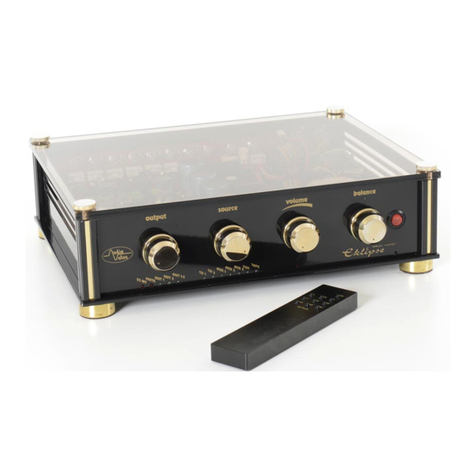
Audio Valve
Audio Valve Eklipse User manual
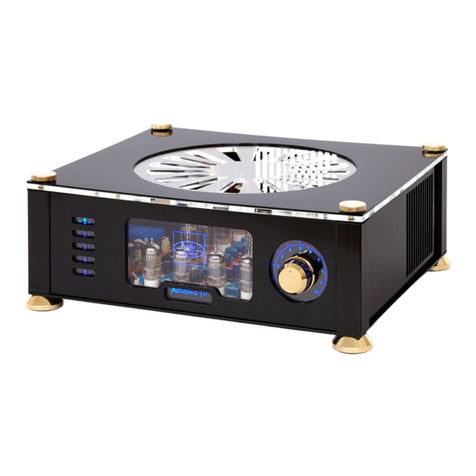
Audio Valve
Audio Valve Assistent 50 User manual
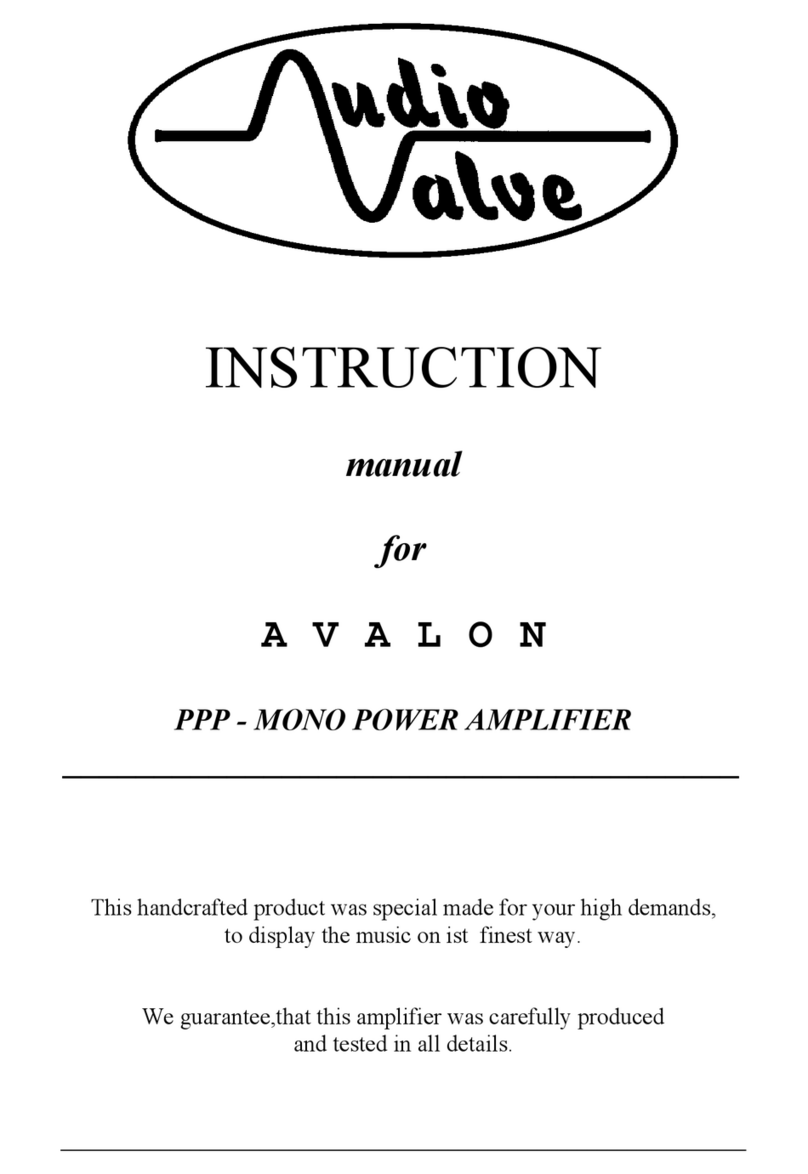
Audio Valve
Audio Valve Avalon User manual
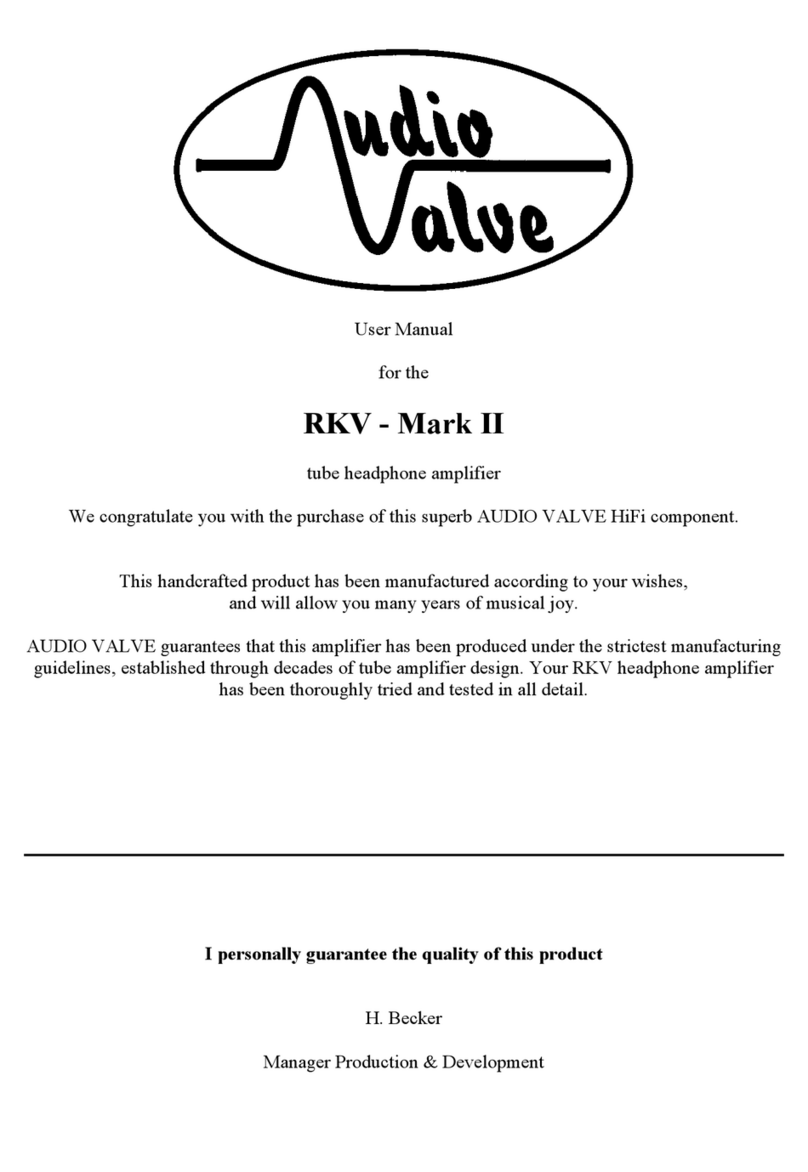
Audio Valve
Audio Valve RKV - Mark II User manual

Audio Valve
Audio Valve BALDUR 300 User manual
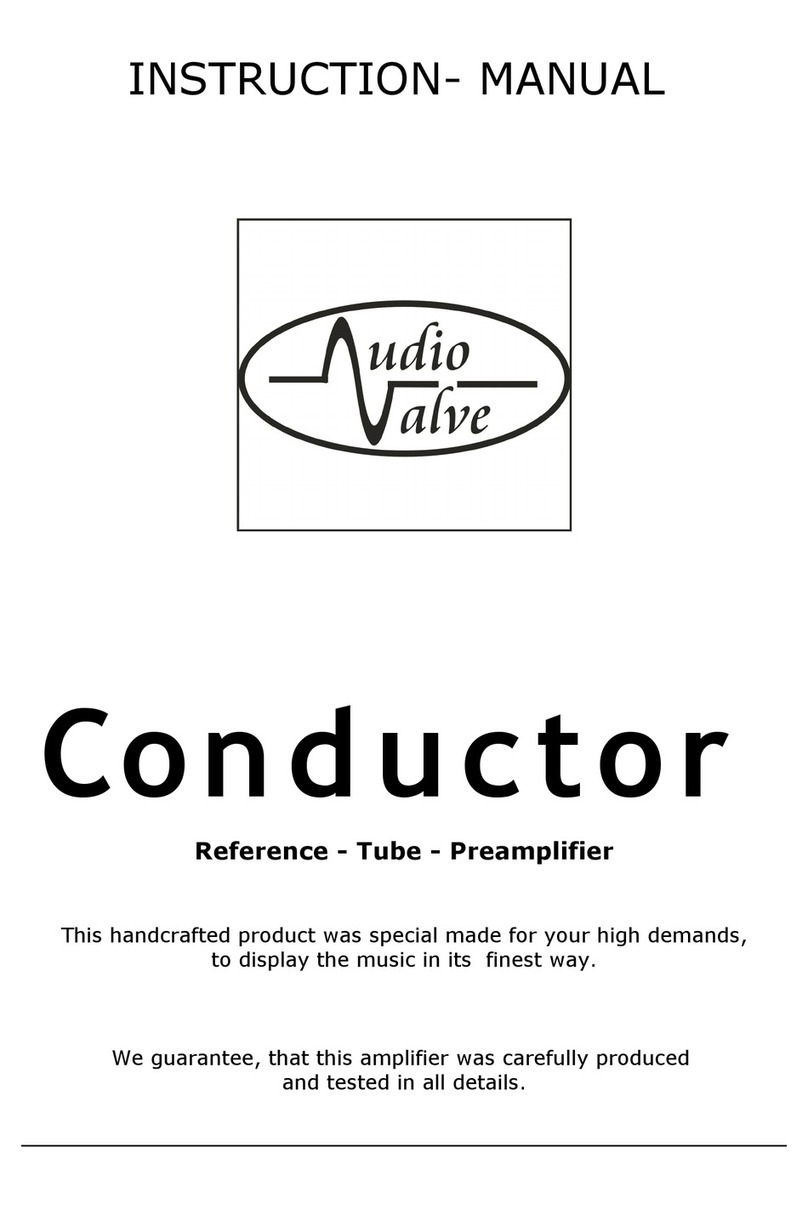
Audio Valve
Audio Valve Conductor User manual

